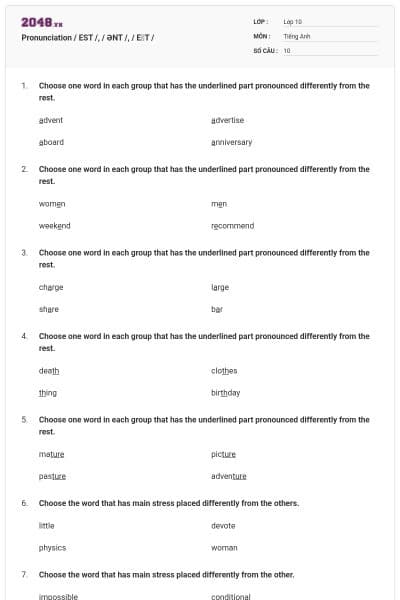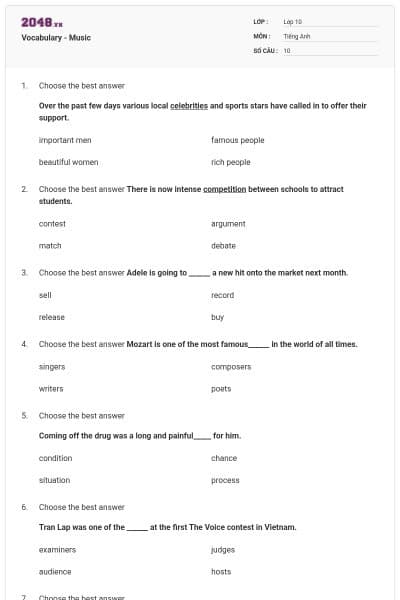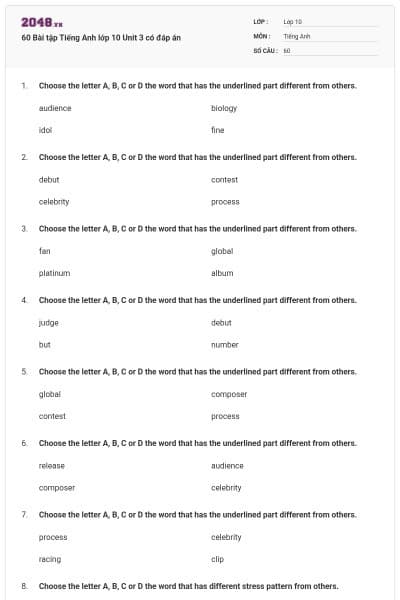5 câu hỏi
Ca Tru was also called “Hat A Dao” or “Hat Noi”. Originally, attractive young female singers entertained men in a relaxed environment, sometimes serving drinks and snacks. Men might have visited a “Hat A Dao” in with friends to celebrate a successful business deal or the birth of a son.
Ca Tru flourished in the 15th century in northern Vietnam when it was popular with the royal palace and a favourite hobby of aristocrats and scholars.
Later, it was performed in communal houses, inns, and private homes, and gained its high popularity.
These performances were mostly for men. When men entered a Ca Tru inn, they purchased bamboo tally cards. In Chinese Vietnamese, “tru” means “card”, and “ca” means “song” in Vietnamese, so the name Ca Tru means tally card songs. The tallies were given to the singers in appreciation for the performance. After the performance each singer received payment in proportion to the number of cards received.
Ca Tru requires at least three performers. The singer is always a woman and plays the “phach”, an instrument made of wood or bamboo that is beaten with two wooden sticks. A musician accompanies the singer on the “dan day”, a long-necked lute with three silk strings and 10 frets. There is also a drummer or “trong chau”. The drummer shows his approval of the singer or the songs depending on how he hits the drum. If he likes a song, he might hit the side of the drum twice. The “dan day” player must follow the rhythm of the “phach”. His instrument, the “dan day”, is only used in Ca Tru and is now made almost exclusively for sale to tourists.
Question: Ca Tru was first performed____.
to serve drinks and snacks to men
to entertain male guests on special occasions
in a relaxed environment without any drink
when “Hat A Dao” and “Hat Noi” disappeared
Ca Tru was also called “Hat A Dao” or “Hat Noi”. Originally, attractive young female singers entertained men in a relaxed environment, sometimes serving drinks and snacks. Men might have visited a “Hat A Dao” in with friends to celebrate a successful business deal or the birth of a son.
Ca Tru flourished in the 15th century in northern Vietnam when it was popular with the royal palace and a favourite hobby of aristocrats and scholars.
Later, it was performed in communal houses, inns, and private homes, and gained its high popularity.
These performances were mostly for men. When men entered a Ca Tru inn, they purchased bamboo tally cards. In Chinese Vietnamese, “tru” means “card”, and “ca” means “song” in Vietnamese, so the name Ca Tru means tally card songs. The tallies were given to the singers in appreciation for the performance. After the performance each singer received payment in proportion to the number of cards received.
Ca Tru requires at least three performers. The singer is always a woman and plays the “phach”, an instrument made of wood or bamboo that is beaten with two wooden sticks. A musician accompanies the singer on the “dan day”, a long-necked lute with three silk strings and 10 frets. There is also a drummer or “trong chau”. The drummer shows his approval of the singer or the songs depending on how he hits the drum. If he likes a song, he might hit the side of the drum twice. The “dan day” player must follow the rhythm of the “phach”. His instrument, the “dan day”, is only used in Ca Tru and is now made almost exclusively for sale to tourists.
Question: Ca Tru developed and became very popular in the society when___.
it was only performed in royal courts and palaces
it took the name Ca Tru from Chinese and became a favourite hobby of aristocrats and scholars
its performances were mostly for men
it was performed in communal houses, inns, and private hom
Ca Tru was also called “Hat A Dao” or “Hat Noi”. Originally, attractive young female singers entertained men in a relaxed environment, sometimes serving drinks and snacks. Men might have visited a “Hat A Dao” in with friends to celebrate a successful business deal or the birth of a son.
Ca Tru flourished in the 15th century in northern Vietnam when it was popular with the royal palace and a favourite hobby of aristocrats and scholars.
Later, it was performed in communal houses, inns, and private homes, and gained its high popularity.
These performances were mostly for men. When men entered a Ca Tru inn, they purchased bamboo tally cards. In Chinese Vietnamese, “tru” means “card”, and “ca” means “song” in Vietnamese, so the name Ca Tru means tally card songs. The tallies were given to the singers in appreciation for the performance. After the performance each singer received payment in proportion to the number of cards received.
Ca Tru requires at least three performers. The singer is always a woman and plays the “phach”, an instrument made of wood or bamboo that is beaten with two wooden sticks. A musician accompanies the singer on the “dan day”, a long-necked lute with three silk strings and 10 frets. There is also a drummer or “trong chau”. The drummer shows his approval of the singer or the songs depending on how he hits the drum. If he likes a song, he might hit the side of the drum twice. The “dan day” player must follow the rhythm of the “phach”. His instrument, the “dan day”, is only used in Ca Tru and is now made almost exclusively for sale to tourists.
Question: The “ tally card” in the meaning of Ca Tru helped____.
the singer to be paid after the performance
the men to purchase bamboo tally cards
the singers to show appreciation for the performance
each singer to receive the number of cards given
Ca Tru was also called “Hat A Dao” or “Hat Noi”. Originally, attractive young female singers entertained men in a relaxed environment, sometimes serving drinks and snacks. Men might have visited a “Hat A Dao” in with friends to celebrate a successful business deal or the birth of a son.
Ca Tru flourished in the 15th century in northern Vietnam when it was popular with the royal palace and a favourite hobby of aristocrats and scholars.
Later, it was performed in communal houses, inns, and private homes, and gained its high popularity.
These performances were mostly for men. When men entered a Ca Tru inn, they purchased bamboo tally cards. In Chinese Vietnamese, “tru” means “card”, and “ca” means “song” in Vietnamese, so the name Ca Tru means tally card songs. The tallies were given to the singers in appreciation for the performance. After the performance each singer received payment in proportion to the number of cards received.
Ca Tru requires at least three performers. The singer is always a woman and plays the “phach”, an instrument made of wood or bamboo that is beaten with two wooden sticks. A musician accompanies the singer on the “dan day”, a long-necked lute with three silk strings and 10 frets. There is also a drummer or “trong chau”. The drummer shows his approval of the singer or the songs depending on how he hits the drum. If he likes a song, he might hit the side of the drum twice. The “dan day” player must follow the rhythm of the “phach”. His instrument, the “dan day”, is only used in Ca Tru and is now made almost exclusively for sale to tourists.
Question: The singer plays the essential role because___.
she accompanies the other musicians with the “phach”, an instrument made of wood or bamboo
she makes the drummer shows his approval of the singer or the songs by hitting the side of the drum twice
the drummer only shows his approval or disapproval to the song and the “dan day“ player must follow the rhythm of the drummer
the “dan day” player must follow the rhythm of the “phach”, and the drummer only shows his approval or disapproval of the singer or the songs
Ca Tru was also called “Hat A Dao” or “Hat Noi”. Originally, attractive young female singers entertained men in a relaxed environment, sometimes serving drinks and snacks. Men might have visited a “Hat A Dao” in with friends to celebrate a successful business deal or the birth of a son.
Ca Tru flourished in the 15th century in northern Vietnam when it was popular with the royal palace and a favourite hobby of aristocrats and scholars.
Later, it was performed in communal houses, inns, and private homes, and gained its high popularity.
These performances were mostly for men. When men entered a Ca Tru inn, they purchased bamboo tally cards. In Chinese Vietnamese, “tru” means “card”, and “ca” means “song” in Vietnamese, so the name Ca Tru means tally card songs. The tallies were given to the singers in appreciation for the performance. After the performance each singer received payment in proportion to the number of cards received.
Ca Tru requires at least three performers. The singer is always a woman and plays the “phach”, an instrument made of wood or bamboo that is beaten with two wooden sticks. A musician accompanies the singer on the “dan day”, a long-necked lute with three silk strings and 10 frets. There is also a drummer or “trong chau”. The drummer shows his approval of the singer or the songs depending on how he hits the drum. If he likes a song, he might hit the side of the drum twice. The “dan day” player must follow the rhythm of the “phach”. His instrument, the “dan day”, is only used in Ca Tru and is now made almost exclusively for sale to tourists.
Question: All of the following are true about Ca Tru EXCEPT that___
it flourished in the 15th century in northern Vietnam
the “dan day” is now only used as a souvenir for tourists
the meaning of Ca Tru partly originated from Chinese Vietnamese
Ca Tru requires at least three performers






